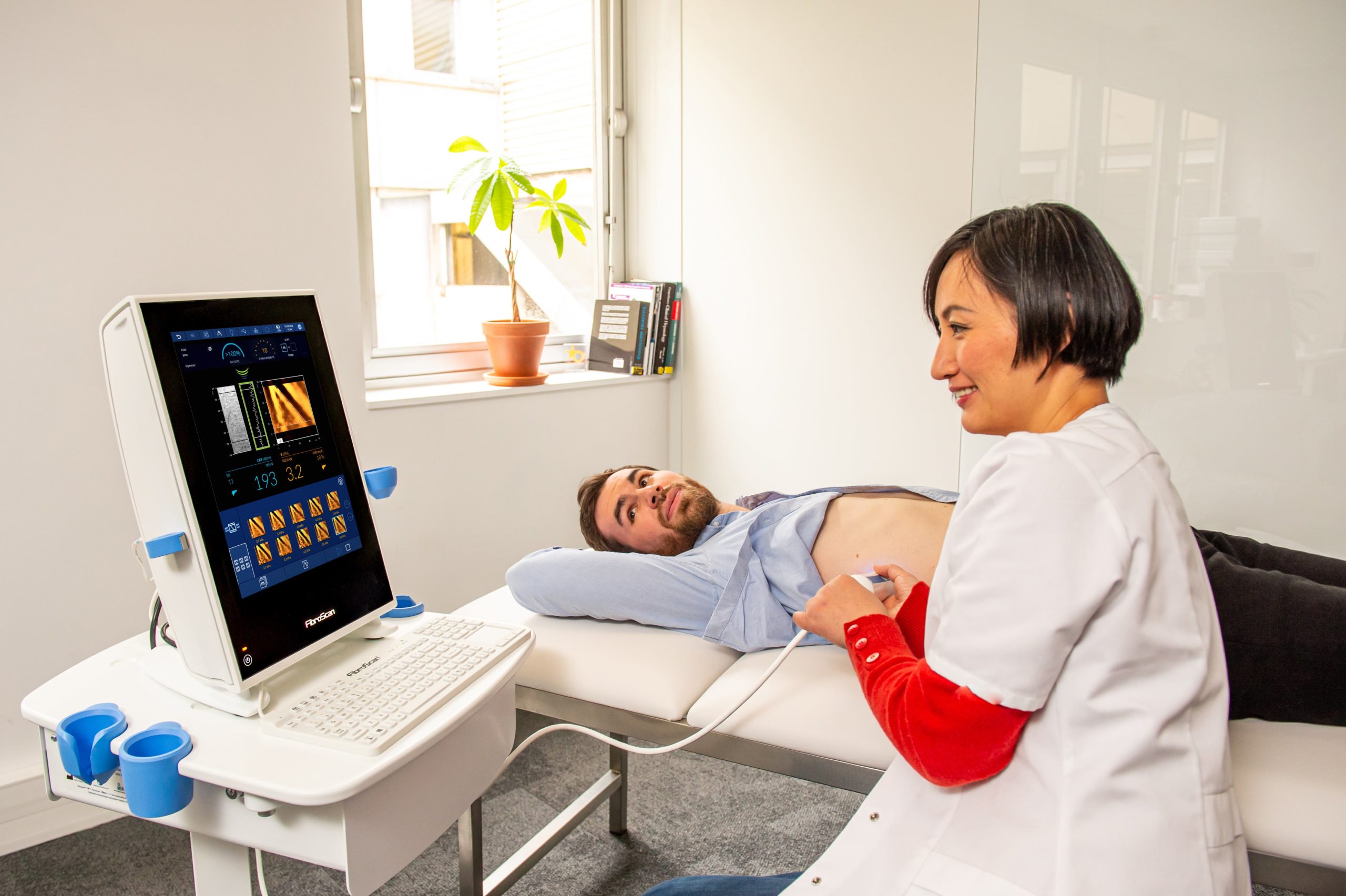Clinical results produced by FibroScan®
Since it was placed on the market in 2003, FibroScan® has featured in more than 2,500 publications in peer-reviewed journals. This wealth of literature and all the clinical data provides a wide-ranging perspective on the clinical relevance of liver stiffness, and constitutes an important tool for the treatment of patients afflicted with chronic liver disease.
Many studies have shown that this measurement performs well for the diagnosis of severe fibrosis and cirrhosis in most chronic liver diseases, such as hepatitis B2 and C3,4, whether isolated or with an HIV co-infection8,9, alcoholic liver disease5, metabolic steatopathies6, and biliary conditions7.
Liver stiffness is not only used to detect and quantify fibrosis; it has also been shown that it is useful for screening the general population10, therapeutic monitoring11, predicting the complications of cirrhosis12,13, detecting a recurrence of liver disease in transplant patients14 and survival prognosis15. Finally, thanks to the use of special probes, FibroScan® has demonstrated its benefits in examining overweight patients (XL probe) 16 and children (S probe) 17.
Measuring ultrasound attenuation
CAP™ (Controlled Attenuation Parameter) was developed by Echosens to quantify liver steatosis. Based on VCTE™, measurement of CAP™ is guided by the stiffness measurement.
In practice, the parameter measured is ultrasound attenuation, expressed in dB/m. It describes the decay of the ultrasound signal according to depth.
The higher the steatosis load in the liver, the greater this decay 18. CAP™ measurement is simultaneous with the elasticity measurement. It is performed at the same location. It is calculated only if the stiffness measurement is valid.
Clinical practice
Because new elastography techniques have been emerging in the medical field, the standardization of elastography procedures is becoming a priority. The FibroScan® exam is the only one that is clearly defined and standardized. To maintain the performance characteristics of the device, the probes are calibrated periodically by manufacturer-approved technicians.
Because the arrival of FibroScan® in hepatology departments has led to changes in medical practice, Echosens also decided to set up a training course to suit each type of operator (physician or nurse). The course includes a personalized theoretical session to understand the operation and criteria for use of the device and its special probes, as well as a practical session where trainees can fully grasp good examination practice.
On completion of the course, operators receive a certificate attesting to the constant quality of their examinations, in terms of both execution and the evaluation of reliability. The exam can be carried out by nursing staff, but only physicians are qualified to interpret the results, in the light of the patient’s entire medical record. As the clinical and technical development of the FibroScan® progresses, each new device and each upgrade justifies the issuing of a bulletin and the creation of a specific new training course.
References :
- Mueller S., Sandrin L. Liver stiffness: a novel parameter for the diagnosis of liver disease. Hepatic Medicine: Evidence and Research 2010; 2:49-67.
- Marcellin P, et al. Non-invasive assessment of liver fibrosis by stiffness measurement in patients with chronic hepatitis B. Liver International 2009;29:242-247.
- Ziol M, et al. Non-invasive assessment of liver fibrosis by stiffness measurement: a prospective multicenter study in patients with chronic hepatitis C. Hepatology 2005; 41:48-54.
- Castera L, et al. Prospective comparison of transient elastography, Fibrotest, APRI and liver biopsy for the assessment of fibrosis in chronic hepatitis C. Gastroenterology 2005;128:343-350.
- Nguyen-Khac E, et al. Assessment of asymptomatic liver fibrosis in alcoholic patients using FibroScan: prospective comparison with seven non-invasive laboratory tests. Alimentary Pharmacology & Therapeutics 2008; 28:1188-98.
- Wong VW, et al. Diagnosis of fibrosis and cirrhosis using liver stiffness measurement in nonalcoholic fatty liver disease. Hepatology 2010;51:454-462.
- Corpechot C, et al. Assessment of biliary fibrosis by transient elastography in patients with PBC
- Vergara S, et al. The use of transient elastometry for assessing liver fibrosis in patients with HIV and hepatitis C virus coinfection. Clinical Infectious Diseases 2007;45: 969-74.
- Miailhes P, et al. Proficiency of transient elastography compared to liver biopsy for the assessment of fibrosis in HIV/HBV-coinfected patients. Journal of viral hepatitis 2011;18:61-69.
- Roulot D, et al. Transient elastography as a screening tool for liver fibrosis and cirrhosis in a community-based population over 45 years. Gut 2010;60:977-84.
- Hezode C, et al. Liver stiffness diminishes with antiviral response in chronic hepatitis C. Aliment Pharmacol Ther 2011;34:656-63.
- Vizzutti F, et al. Liver stiffness measurement predicts severe portal hypertension in patients with HCV-related cirrhosis. Hepatology 2007;45:1290-7.
- Masuzaki R, et al. Prospective risk assessment for hepatocellular carcinoma development in patients with chronic hepatitis C by transient elastography. Hepatology 2009;49:1954-61.
- Carrión J.A, et al. Liver stiffness identifies two different patterns of fibrosis progression in patients with HCV recurrence after liver transplantation. Hepatology 2010; 51:23-34.
- Vergniol J, et al. Non-Invasive Tests for Fibrosis and Liver Stiffness Predict 5-Year Outcomes of Patients with Chronic Hepatitis C. Gastroenterology 2011;140:1970-9, 1979 e 1-3.
- Myers RP, et al. Feasibility and diagnostic performance of the FibroScan XL probe for liver stiffness measurement in overweight and obese patients. Hepatology 2012; 35:199-208.
- Chongsrisawat V, et al. Transient elastography for predicting esophageal/gastric varices in children with biliary atresia. BMC Gastroenterology 2011;11:41.
- Sasso, M., et al., Novel Controlled Attenuation Parameter (CAP) for noninvasive assessment of steatosis using Fibroscan®: validation in chronic hepatitis C. Journal of Viral Hepatitis, 2012. 36(1): p. 73-20.
